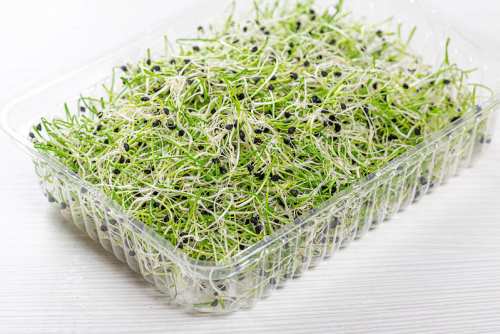In the pandemic and lockdown, we all are staying indoors and have inculcated a habit of growing plants every day, and those plants when bloom look so good. Thus microgreen is one of the plants we can grow at the farm and house. We need to understand what a microgreen is and more details.
A microgreen is a seedling of any vegetable or herb. Microgreens are very healthy to eat as they remove many health issues.
There are many microgreens available such as Broccoli microgreen: Broccoli microgreens’ anti-inflammatory features will aid in the removal of toxins from the body. Broccoli microgreens are high in vitamin A, C, E, and K, as well as protein and calcium, as well as iron, magnesium, and phosphorus. To get the most out of this versatile green, add a handful of broccoli microgreens to your soup, smoothie, or sandwich. Broccoli microgreens seeds grow best in a soil-based medium and can be harvested after 8 to 10 days.
Radish microgreens: Radishes are a good way to start with microgreens. They germinate quickly (1 to 2 days) and grow swiftly in both warm and chilly environments. They’re usually ready to harvest in 5 to 10 days. Radish microgreens are strong in vitamin C, but they also have a wide range of vitamins and minerals. They also contain a significant quantity of protein. Radish microgreens do not require pre-soaking and prefer to be grown hydroponically, though they will grow in soil as well.
Growing Onion Microgreens at Home

One of the main being Onion microgreen Onion belongs to the family of Amaryllidaceae. Onion microgreens are simple to cultivate, but they take a long time to grow, especially if this is your first time. It will take between 12 and 21 days for these fresh greens to be ready to harvest. Onion microgreens contain Vitamins A, B, C and E, calcium, iron, zinc, phosphorus, magnesium, potassium and amino acids.
- Flavor: Savory, onion taste; garlic aftertaste
- Soak: Optional
- Rinse/Drain: No
- Germination: 3-4 days
- Ideal Harvest: 12 days
What do you need to grow onion microgreens?
- Onion seeds of any variety
- Container: at least two shallow containers, such as these, that can be poked with a hole.
- Medium for growth: Coconut coir or Espoma seed starting mix
- Light: The Agrobrite T5 grow light or natural sunlight
- Spray bottle
- Shears for the kitchen
Though we talk about growing onion microgreens but do we know that they benefit us also in many ways:
- Microgreens help in boosting your immunity as the content of vitamins is high and also microgreens are nutritious and can be eaten raw.
- It also minimizes the risk of diseases such as heart disease, anemia, low cholesterol level and also controls our blood pressure level
- Researchers have also found that microgreens are one reason for not having constipation.
- For all those people who wear spectacles for eyes they should eat because it also improves and controls your eyesight number.
It’s not always necessary for you to buy microgreens from outside, if you are willing to grow onion microgreen at home you can follow these instructions:
Microgreens are simple to grow since they don’t require a lot of equipment or time.
They may be cultivated indoors or outdoors all year.
Also Read: How to Get Rid of Mold on Microgreens?
Materials required:
- Seeds of good quality
- An excellent growth medium, such as potting soil or homemade compost in a container. You may also use a single-use growth pad made particularly for producing microgreens.
- Proper lighting — preferably 12–16 hours per day of sunshine or UV illumination
A method to grow at home:
- Fill your container with soil, being careful not to over-compact it, and softly water it.
- Spread the seed of your choice as evenly as possible on top of the soil.
- Using a light mist of water, lightly spray the seeds and cover your container with a plastic lid.
- Check your tray regularly and spray the seeds with water as needed to keep them wet.
- Remove the plastic top after few days when seeds have sprouted to expose them to light.
- While your microgreens grow and develop color, water once a day.
- Your microgreens should be ready to harvest after 7–10 days.
- Things to keep in mind while growing microgreens that you should choose seeds that have not been treated with any chemicals.
- To guarantee that the microgreens develop successfully, use excellent quality, chemical-free soil.
- Don’t overwater your microgreens, and make sure your container has drainage holes.
- Climate is one thing to be kept in mind because some microgreens can grow in some temperatures and some cannot
How Actually Onion Microgreens are Grown?
#1. Soaking:
The seeds of onion are very small and generally, people don’t soak them before planting but a couple of hours soaked in water may help them germinate faster and the output will also be good.
#2. Planting
To begin, put several drainage holes in a growth tray and fill it nearly to the top with dirt. Wet the dirt with the spray bottle and pack it down. We’re all set to start sowing seeds!
Distribute your microgreens seeds evenly throughout the soil surface, including the tray’s corners (you may want to use a shaker bottle). The seeds should be in close proximity to one another. You must, however, guarantee that they are not contacting one other.
Onion seeds, when grown too close together, produce the ideal environment for fungal development in the soil. Instead of covering the seeds with dirt, leave them exposed. Give your onion seeds a nice spritz of water after planting to help them germinate, and then lay the second tray directly on top of them (right side up).
While pushing the onion seeds into the earth, this produces darkness for them to grow in. To guarantee that no light reaches the seeds, you can add up to 5 pounds of weight to the cover. When the onion microgreens begin to develop after germination, they will collectively push up the cover and weight.
#3. Growing
Keep your seeds in the dark for at least 3-4 days after they’ve been planted. During this period, they don’t require water. Remove the seed cover once the seeds have grown into seedlings and are yellow in colour. The sprouts may appear squashed at first, but in the light, they will rapidly rise (and turn green).
Directly beneath the grow light, place your onion microgreens. Because the shoots grow towards the light, we choose artificial light for indoor microgreen growth. The microgreens will develop unevenly if the trays are merely put on a windowsill. You’ll also be able to manage how much light the trays receive each day with a grow lamp (we recommend 8-12 hours).
#4. Harvesting
Onion microgreens have a longer harvest shelf life than most. You’ll be able to harvest in stages rather than all at once (though you can certainly do just one big harvest). However, keep in mind that the flavour of the microgreens will alter as they grow, so don’t wait too long.
As the onion microgreens grow, the tips of the microgreens may dry off. Harvest your onion microgreens when they reach 4 inches in height and begin to lean over (they’ll resemble unmowed grass). Clip the onion microgreens in bunches at least 12 inches above the soil surface with clean kitchen shears (or something similar).
Instead of growing from the top of the stem, onions grow from the bottom. This implies we’ll be able to get another crop out of the trays. Simply continue to care for the microgreens until they regenerate and may be picked once again.
#5. Storing
After harvesting the onion microgreens, don’t wash them until you’re ready to utilize them. As previously stated, the seed husks can be left on or removed from the onions. Whichever green you select, you’ll get a great onion taste with no effort (they won’t even make you weep when you cut them!).
Keep your microgreens, onion, or otherwise, in the fridge in a sealed container. They should last for up to a week if you put a paper towel in the bag to absorb any excess moisture.
This is your journey of growing onion microgreens.
